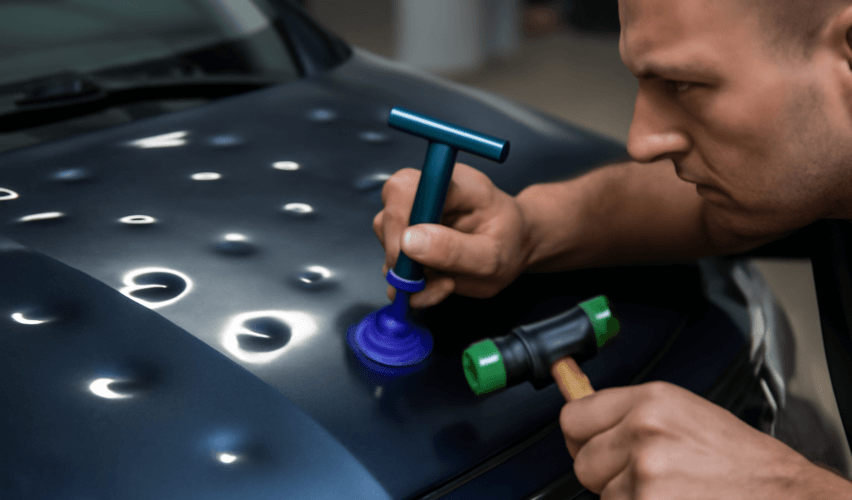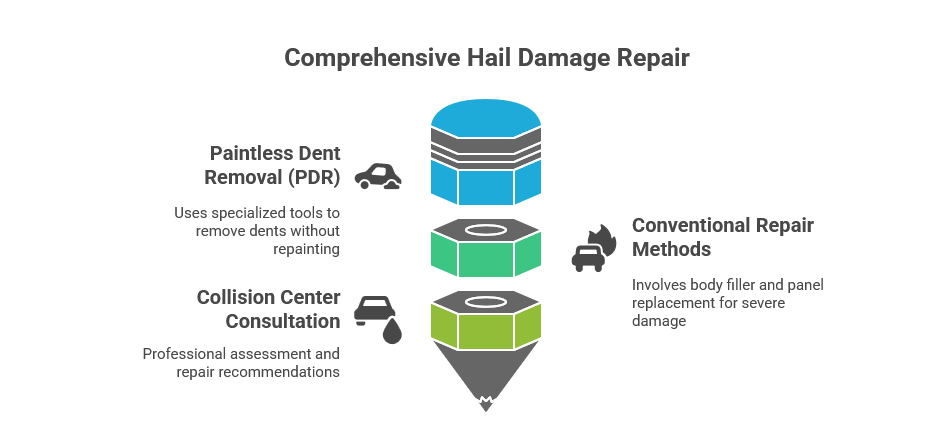This article was updated in August 13, 2025 with new products and information by Mark S. Taylor
Hail damage can leave your car with unsightly hail dents, small dents, and even severe damage depending on the size of the hailstones. For car owners, knowing how to repair hail damage on a car is essential to maintaining its appearance and value. Whether you’re dealing with minor dents or significant damage, there are multiple repair options available to restore your car’s surface to its original shape.
From DIY methods like using a suction cup or dry ice to professional solutions like paintless dent removal, you can address hailstorm damages effectively. However, understanding the extent of the damage and whether you need professional help is the first thing to consider. In this guide, we’ll cover everything you need to know about hail damage car repair, from evaluating repair costs to preventing further damage.

Contents
Understanding the Extent of Hail Damage
Recognizing hail dents and other affected areas
After a hailstorm, the first thing car owners should do is inspect their vehicle for hail dents and other signs of damage. Focus on the car’s surface, looking for small dents, shallow dents, or significant damage caused by hailstones. Check the windshield and side panels for potential hailstorm damages, as these areas are particularly vulnerable. Hailstones can vary in size, with golf ball-sized dents being especially common during severe weather. Pay close attention to the roof, hood, and trunk, as these flat areas often bear the brunt of hail impact.
Evaluating cosmetic vs. structural damage
Once you’ve identified the affected areas, assess whether the damage is cosmetic or structural. Cosmetic damage, such as minor dents or paint damage, can often be repaired using DIY methods or professional techniques like paintless dent removal. However, more severe damage that compromises the structural integrity of the car, such as panel misalignment or deep dents in the metal surface, typically requires professional help. Understanding the type of damage will help you choose the best repair options for your hail-damaged car.
DIY Methods to Repair Hail Damage
Effective techniques for minor dents
If the damage is limited to minor dents, you can try some DIY methods to restore the car’s original shape. One popular method involves using a suction cup or a dent puller to gently lift small dents from the surface. Another approach is applying dry ice to the dented area. The rapid cooling effect of dry ice causes the metal surface to contract, which can help pop out shallow dents. Alternatively, a heat gun can be used to warm up the dented area, followed by cooling it down quickly to encourage the metal to revert to its original shape.
Why DIY might not be the best way
While DIY methods can be effective for minor dents, they aren’t always the best way to address hail damage. Using improper techniques or tools could cause further damage to the car’s surface or paint. For more serious hail damage, such as golf ball-sized dents or damage that affects surrounding areas, professional help is recommended. Attempting to fix severe hail damage on your own might lead to costly mistakes and compromise the car’s factory finish.

Professional Hail Damage Repair Options
How paintless dent removal (PDR) works
One of the most effective professional techniques for hail damage repair is paintless dent removal, or PDR. This process involves specialized tools and techniques, such as glue pulling, to gently remove dents without disturbing the original paint. PDR technicians are trained to work carefully on hail-damaged vehicles, ensuring that the factory finish is preserved. This method is ideal for shallow dents and small dents, as it restores the car’s surface to its original shape without the need for repainting.
Conventional repair methods for significant damage
For significant damage or severe hail damage, conventional dent repair methods may be necessary. These methods include the use of body filler to smooth out dents or even panel replacement for areas with extensive damage. In cases of severe hail damage, visiting a collision center and consulting an auto body technician is often the best option. These professionals can assess the extent of the damage and recommend the appropriate vehicle repair solutions to restore the car’s appearance and structural integrity.
Estimating Repair Costs and Insurance Coverage
Factors affecting hail damage repair cost
The cost of repair for hail-damaged vehicles depends on several factors, including the extent of the damage and the type of damage. For minor dents or cosmetic damage, the hail damage repair cost may be relatively low. However, severe damage that requires traditional repair methods, such as panel replacement or significant paint repair, can increase repair costs significantly. The size of the dents, the number of affected areas, and the car’s original paint condition also play a role in determining repair costs.
Filing hail damage claims with your insurance provider
If your car insurance policy includes comprehensive coverage, you may be able to file a hail damage claim with your insurance provider. Start by contacting your insurer to report the damage and request a free estimate. Be sure to provide all necessary details, including photos of the hail-damaged car and a phone number where you can be reached. It’s also important to verify whether filing a claim will impact your insurance rates. Many car owners find that insurance coverage can significantly reduce the cost of hail damage repair.
Preventing Future Hail Damage
While hail damage is often unavoidable, there are steps you can take to protect your car during severe weather. Using a car cover designed for hail protection can shield your vehicle from hailstones. Whenever possible, park your car in a garage or covered area to minimize exposure to hailstorms. If you’re caught in a hailstorm while driving, avoid parking lots or open areas where hailstones are likely to cause further damage. Staying alert to weather warnings and taking preventive measures can help you avoid such damage to your car in the future.
Restoring Your Car’s Looks and Value
After addressing hail damage, the ultimate goal for car owners is to restore their vehicle’s appearance and value. Choosing the best way to repair hail damage is crucial for ensuring the car looks as good as new. Professional services, such as paintless dent removal or conventional repair methods, can help maintain the car’s factory finish and structural integrity. These methods not only improve the car’s surface but also prevent further damage that could result from untreated dents or paint issues.
For those looking to sell or trade in their vehicle, repairing hail damage is essential for retaining its market value. Car dealers and buyers often inspect for cosmetic damage and may offer lower prices for hail-damaged vehicles. By consulting professionals or visiting a collision center, you can ensure your car is in top condition and ready for resale or continued use. Don’t forget to provide your phone number when scheduling repair appointments to streamline the process and get your car back on the road quickly.
Frequently Asked Questions
How Do You Pop Hail Dents Out of a Car?
To pop hail dents out of a car, you can use a heat gun to soften the area and a plunger to pull out the dent. Alternatively, dry ice can be used for a similar effect. However, this method might not work for every type of dent, and professional help may be needed for larger or deeper damage.
Can You Fix Hail Damage on a Vehicle?
Yes, hail damage can be fixed using techniques like paintless dent repair (PDR). This method involves massaging the dents out from the underside of the panel. If the paint is damaged, traditional bodywork may be needed. Consult a professional to determine the best option for your car.
How Much Will It Cost to Repair Hail Damage on My Car?
The cost of hail damage repair can vary based on the extent of the damage and your location. Minor dents can cost between $150 and $500, while extensive damage may run from $2,000 to $4,000 or more. Insurance often helps with the cost, so it’s important to check with your provider.
Is It Worth Claiming Hail Damage to a Car?
It may be worth claiming hail damage to your insurance, especially if the damage is significant. Many insurance policies cover hail damage under comprehensive coverage. However, consider your deductible and the amount of damage—sometimes it might be better to pay out of pocket for smaller repairs.
How to Prove Hail Damage to Insurance Company?
To prove hail damage to an insurance company, take clear, detailed photos of the damage. Document the size and location of the dents, and provide any relevant weather reports indicating hail in your area. A professional repair estimate can also support your claim and speed up the process.
My Final Thoughts on How to Repair Hail Damage on Your Car
If you like to save money and fix things yourself, try DIY hail repair. It worked for me. A hair dryer or dent kit saved my car after a storm hit it hard. But if you want top dollar when you sell your car, or have big dents, call a pro.
Think of it like fixing a coat. Small holes? You can patch them. Big rips? Need a tailor. It’s okay to ask for help if the dents look too hard. I felt scared at first too. Each fix got easier. Your car can look good again. Just pick the right fix for you.
